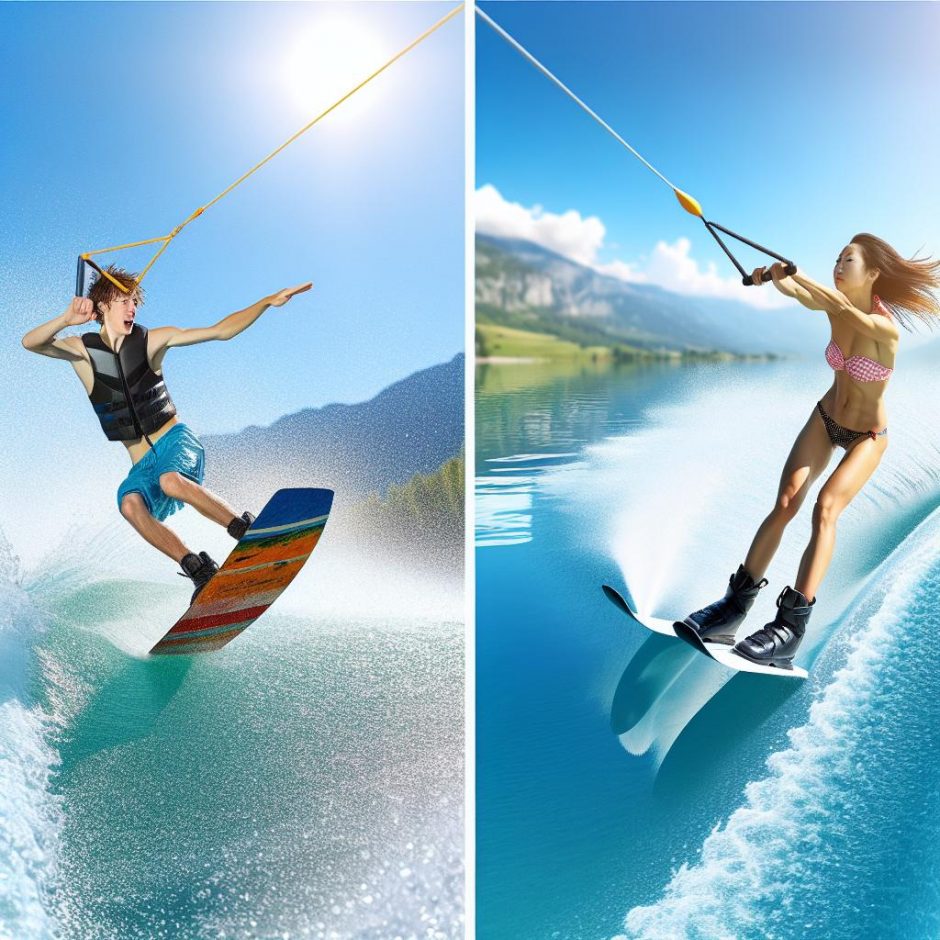Overview
Engaging in water sports like wakeboarding and waterskiing offers an exciting way to experience the thrill of being pulled across the water by a boat. Although these sports are both aquatic and involve similar fundamental principles, they each come with distinct differences in terms of equipment, techniques, and cultural nuances. For water sport enthusiasts, understanding these differences can greatly influence the choice between wakeboarding and waterskiing based on personal preferences and skill levels.
Equipment Differences
Wakeboarding is characterized by the use of a board that has a similar structure to a snowboard. Typically, the board is equipped with bindings to help secure the rider’s feet firmly. This design allows the rider to have complete control and stability over the board while performing various maneuvers. The wakeboard’s relatively shorter and wider build enables greater agility, facilitating stunts and tricks. Fins attached to the bottom of the board enhance steering and provide stability, making it easier for riders to navigate across the water surface.
In contrast, waterskiing employs a different set of equipment. Waterskiers use long, narrow skis; beginners often use a pair of skis while more advanced skiers may opt for a single ski in disciplines like slalom skiing. The bindings on waterskis offer versatility through their adjustable design, which accommodates diverse foot sizes. This adjustability makes waterskiing accessible to a wide range of participants. The skis are engineered for speed and swiftness, enabling skiers to slice through water with less resistance offering a gliding experience.
Technique Differences
Wakeboarding involves a stance that is akin to that of snowboarding, where the rider stands sideways in relation to the direction of travel. Mastery of balance is key in wakeboarding, especially since the board’s design allows for and encourages tricks such as jumps and various spins. Riders must maintain an aligned posture with the board to ensure control, particularly during aerial stunts. The physical act of wakeboarding thus combines dynamic movements with strategic body alignment to achieve an exciting array of tricks.
In stark contrast, waterskiing demands a forward-facing stance. Skiers position their feet parallel and keep their knees slightly bent to absorb the impact of moving at higher speeds. Turning is achieved through body weight adjustment, leaning left or right as needed — reminiscent of skiing techniques used on snow. Given that waterskiing often involves higher velocities than wakeboarding, the emphasis is on maintaining stability and precision. Mastery of speed control is vital to successful waterskiing, affecting the skier’s ability to navigate through the water effectively.
Skill Development
Both wakeboarding and waterskiing necessitate a level of physical fitness, but they prioritize different capabilities. Wakeboarding lays significant emphasis on core strength and equilibrium. The nature of the sport, focusing on trick execution and maintaining a stable position even when airborne, makes robust core muscles indispensable. The art of balancing on a wider board while performing aerial maneuvers exemplifies the reliance on the rider’s core.
In comparison, waterskiing puts a higher demand on leg strength and endurance. Skiers need to sustain speed and execute precision turns over a more extended period, which translates into a sustained physical effort. The musculature of the legs and lower body is constantly engaged, strengthening these areas through continuous exertion and control.
Cultural and Competitive Aspects
The cultural landscape surrounding each sport adds a unique layer to the experience. Wakeboarding competition scenes often reward creativity and style, with athletes showcasing their prowess through a combination of flips, spins, and jumps. This competition structure fosters a culture that resonates with other extreme sports like skateboarding and snowboarding, where charisma and flair are integral components of the sport.
On the other hand, waterskiing competitions have a somewhat more traditional approach. Whether it’s slalom racing, trick skiing, or jumping, waterskiing events focus on speed, precision, and technique. Participants aim to achieve remarkable accuracy and skill level, adhering to time-honored traditions of the sport. The waterskiing community often values discipline, perseverance, and technical skill above all else.
Final Thoughts
Ultimately, the decision to engage in wakeboarding versus waterskiing largely boils down to what type of experience an individual is seeking. Both sports provide invigorating and enjoyable experiences but appeal to different kinds of athleticism and personal preferences. Whether it’s the agile, trick-oriented exploits of wakeboarding or the speed and precision-focused engagement of waterskiing, each offers a unique way to interact with water. Participating in either sport provides an avenue for recreation and skill enhancement, allowing enthusiasts to connect deeply with nature’s elements while pursuing personal challenges and growth.
For those who are poised to start their water sports journey, a plethora of resources are available, offering guidance and information on how to commence either wakeboarding or waterskiing. By exploring these resources, beginners can pave the path toward a fulfilling experience on the water.

